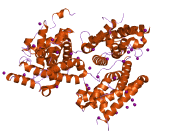You have reached the HIVandHepatitis.com legacy site. Please visit our new site at hivandhepatitis.com
| HIV
and Hepatitis.com Coverage of the
61st Annual Meeting of the American Association for the Study of Liver Diseases (AASLD 2010) October 29 - November 2, 2010, Boston, MA |
|
|||||||||||||||||||||||||||||||||||||||||||||||
|
Higher
Doses May Overcome Poor Response to Interferon in Hepatitis C Patients
with Unfavorable IL28B Gene Pattern
 In
2009, researchers
first reported that specific variations in the IL28B gene region --
which encodes interleukin 28, also known as interferon lambda -- are associated
with both spontaneous clearance of hepatitis
C virus (HCV) and response to interferon-based therapy for chronic
infection. Different teams have implicated several single nucleotide polymorphisms
(SNPs), or changes at a single local in the genetic sequence. The same
genetic variation may also influence hepatitis B
outcomes. In
2009, researchers
first reported that specific variations in the IL28B gene region --
which encodes interleukin 28, also known as interferon lambda -- are associated
with both spontaneous clearance of hepatitis
C virus (HCV) and response to interferon-based therapy for chronic
infection. Different teams have implicated several single nucleotide polymorphisms
(SNPs), or changes at a single local in the genetic sequence. The same
genetic variation may also influence hepatitis B
outcomes.
Each individual carries 2 copies of the relevant gene. People with the C/C genetic pattern -- that is, 2 copies of the "C" allele, or variant -- are more likely to clear HCV without treatment and to respond well to interferon alfa if chronically infected. People with the T/T pattern have the least favorable response. Those who carry 1 "C" and 1 "T" allele fall somewhere in between. Different racial/ethnic groups are more likely to have specific patterns -- the protective C/C pattern, for example, is more common among people of European descent -- which may help explain disparate treatment response rates. In the study described at the Liver Meeting, Robert Roomer from Erasmus University Medical Center in Rotterdam and colleagues explored links between IL28B patterns and treatment outcomes among chronic hepatitis C patients who did not respond to a prior course of therapy. Standard therapy using once-weekly pegylated interferon alfa plus weight-adjusted daily ribavirin produces a sustained virological response (SVR) rate of only about 10% in this population. The researchers hypothesized that continuous delivery of high-dose interferon by an external pump might improve SVR rates in previous non-responders. The pegylation process enables interferon alfa to remain active in the body longer than the conventional formulation, but a pump allows for a stable high concentration. A total of 30 chronic hepatitis C patients with prior treatment failure where given interferon alfa-2b (the type in Intron A and PegIntron) continuously administered via subcutaneous infusion using a modified Medtronic Minimed insulin pump. Participants were randomly assigned to receive cumulative daily doses of 6, 9, or 12 MU of interferon, combined with weight-adjusted daily ribavirin. Viral kinetics were measured at baseline, weekly until week 4, and then at weeks 8, 12, 24, and 48. The IL28B SNP rs12979860 -- dubbed the "Duke SNP" -- was assessed using competitive allele-specific PCR genotyping. Results
These results show that the IL28B genotype can be a strong predictor of both viral decay rates and subsequent SVR," the investigators concluded. Moreover, they added, "high doses of interferon can potentially overcome the innate lack of interferon sensitivity" associated with unfavorable IL28B gene patterns in prior studies of treatment-naive patients. Finally, they noted, "these results also support the concept that continuous delivery of interferon in previous therapy failures can be a successful treatment strategy," especially for those with C/C and C/T gene patterns. Investigator affiliations: Department of Gastroenterology and Hepatology, Erasmus University Medical Center, Rotterdam, Netherlands; Ventures & New Therapies, Medtronic, Inc., Minneapolis, MN, and Los Angeles, CA. 11/12/10 Reference |
|
|||||||||||||||||||||||||||||||||||||||||||||||